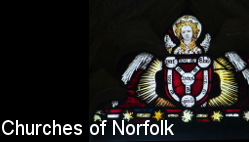| |
|
St
Andrew, Honingham I had almost given up hope of seeing inside
Honingham church, until my friend John told me he'd
arranged for it to be open, and would I like to come
along? In truth, I was wary about meeting a character I
had encountered at the church some ten years previously;
not so much for what had happened, but that I had written
about it in some detail afterwards. I was a little
apprehensive, therefore, to turn up and discover that the
man opening the church was the same one I had met all
those years before. But it didn't matter, because he
didn't remember me, and probably had never read what I
had written.
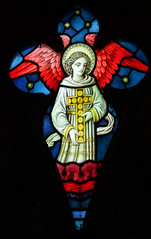 |
|
And
I found I liked Honingham church rather more than
I had expected to. There is a rich atmosphere of
the last decade of the 19th Century and the first
decade of the 20th, and the Victorian glass is
really very good. It can't have much of a
congregation, and I decided that it was
essentially a churchwarden's hobby church, a
fiefdom. He obviously did everything here, kept
in in good order looking spick and span and
shipshape, and locked it determinedly against
anyone who wanted to see inside without attending
a service. I imagined that even God
would have to wipe his feet and mumble
apologetically if he wanted to get inside. All
well and good for now, but once the churchwarden
has gone it will soon be lost to us.
In
2006, I had written: This big, locked,
Perpendicular building, the nave and chancel
rebuilt by the Victorians, is surrounded by a
wide graveyard. On the north side there are
sparsely scattered headstones, but to the south
the church is set within a wide murderous curve
of the A47. To describe this church as a landmark
on the road is to assume that it would be safe to
look up from the wheel to spot it; the stretch of
the road between here and Hockering has claimed
more deaths than any other since the A47 was
taken outside the villages. I'm not suggesting
that the church is responsible for this, of
course, just that spotting it shouldn't be one of
your priorities.
|
If a
Martian came down and landed in the graveyard of St
Andrew, Honingham, what on earth he would make of it?
Would he think it was an art object? A barn, or storage
facility? Or would he search for an industrial purpose?
Perhaps the tall pinnacles on the tower might suggest to
him that he was at the site of a scientific experiment.
If the
Martian had any brains, and I assume that he would have
if he'd made it this far, he might perceive that the road
is a lot newer than the church, and perhaps he would
decide that the church was a relic of the past, its
function now sidelined, perhaps forgotten altogether.
Indeed, he might wonder if the road had been built
deliberately to speed humans past this building and the
tall stones set around it.
Perhaps
this was a dangerous place. Or, maybe, it was simply an
embarassing reminder of past superstitions, a haunted
site. An unlucky place, perhaps. The Martian might watch
the traffic hurtling past, the drivers deliberately not
looking, and think yes, that must be right. Whatever he
decided, it would have to be based on a survey of the
exterior, because St Andrew is always locked,
unless the Sunday club is in session. He wouldn't even be
able to look through the windows, because they are filled
with frosted quarries.
Eventually, he might find the porch, and
think it is some sort of antechamber (not an entrance, of
course, for the doors beyond are locked) and for a moment
ponder the holy water stoup, now filled with an old birds
nest. What on earth would he make, I wonder, of the
signboard on the wall that reads in part:
Friend, you have come to this church.
Leave it not without a prayer.
No one entering a house ignores him who dwells in it.
This is the house of God, and He is here.
Pray, then, to him who loves you, and bids you welcome,
and awaits your greeting.
A lovely sentiment, no doubt; but the
Martian would still be left locked out of the house of
God - if it is the house of God, of course, for
if the locks and chains keep out the stranger and the
pilgrim, how on earth can it be that God is in there to
bid us welcome?
My friend Peter has been trying to see
inside this church for years. We came this way most
recently in early March, 2006. The day had started in
bright sun, but as we headed here from Marlingford the
east wind blew sheets of glacial cloud above us, which
turned grey and, as we parked the car, turned to snow.
Parking is difficult; there is a layby, but you need to
approach from the west to park here. Otherwise, there is
a drive which goes up to the east end of the church, but
this was already occupied by a large BMW estate. We
parked in the layby, and sat in the car for a moment,
watching the fat flakes thicken.
What to do? We decided that we might just as
well get out and go and take a look. Either, by some
miracle, the church would be open and offer us shelter,
or we could confirm our prejudices about the perpetual
locking of St Andrew and be on our way.
The south side of the church has been
cleared of headstones, and they have been placed in two
perfectly straight lines, about 15 m apart. What would
the Martian make of this? Some sort of sports arena,
perhaps? Or a place to worship the sun at the solstice?
Our Martian couldn't possibly be expected to
know about the great lawnmower enthusiasm of the 1960s
and 1970s, when so many graveyards were cleared like this
one. But the dead have their revenge, and this wide open
space is now scattered with an acne of molehills.
We got into the porch and tried the inner
door, which was locked of course; although it did feel as
though one great shove with a shoulder would probably
open it. And that was when the heavens opened. The snow
was so thick in the air we could only just make out the
suicidal cars thrashing up the main road to and from the
Midlands. Peter is a careful driver, and he didn't much
fancy heading on in a blizzard, and there didn't seem
much point getting caked in snow just to go back and sit
in the car, so we sheltered from the weather in the
porch, and read the notices miserably.
I noticed that the presentation to the
living had been suspended, which sounds drastic but
simply means that the parish can't afford a Rector. The
annual accounts were posted, and I noticed that the total
income for the year was roughly the same as the weekly
income of the church I attend in the middle of Ipswich,
so this is a small parish. Eventually, I exhausted the
possibilities of the noticeboard, and, feeling that I had
probably squeezed the last ounce of pleasure out of the
porch, I gazed out at the graveyard. This was when I
noticed something rather curious. The back of the BMW
estate was open, and beyond the second line of
gravestones a smartly dressed man was standing in the
snow bashing molehills with a spade.
At first I thought this must be an act of
devotion on the part of a parishioner, or simply a
Saturday morning habit. And then I wondered if it might
be some kind of country lore: if in the snow you
clear his stack, mister mole will not be back -
perhaps this man had been waiting for it to snow for months.
We watched him for a while, the snow
blanketing the sound of his spade into silence, rendering
it surreal. But the wind was vicious, and so we stepped
back into the porch, and worked out where we wanted to go
next. It was while we were pondering over the map that we
heard footsteps, and looking up saw that the smartly
dressed man had approached us. He looked at us
quizzically.
"Just here out of interest?" he
asked.
"Well, we'd like to be", I
replied, indicating the door. "But the church is
locked."
This was such a heavy hint that, once
dropped, it hit the floor with a loud clang.
Surely, if this man had a key, he'd give it to us, or let
us in. But he just smiled sadly and nodded in agreement,
as if to say yes, the church was locked, and
there was nothing he could do about it. Perhaps he'd been
trying to see inside for years as well. Instead, the
three of us exchanged a few polite comments about the
weather, and he wandered off back to his moles.
And then ten years passed, and here I was
again at Honingham church. No moles now, and so the
churchwarden was at leisure to let us in through the
chancel door. The first impression was of the jewel-like
intensity of the chancel windows, several the work of
George William Taylor soon after he had taken over the
O'Connor workshop in Berner Street, London in 1877.
Indeed, the windows are actually signed Taylor late
O'Connor. I always find Taylor's manga-eyed women a bit
mawkish, but in these early days he was probably working
with the O'Connor pattern book, and the combination of
their cartoons and his romanticism is very pleasing, even
if there is a bit of manga creeping in. But in the end,
Taylor was unable to revive the O'Connor's fortunes. The mass-produced glass of the workshop was
becoming unfashionable with the rise of the Arts &
Crafts movement, and they weren't able to compete with
the economies of scale of the really big workshops like
Hardman & Co and Ward & Hughes. They produced
their last glass in about 1900 and the company closed
soon afterwards. The main subjects here are all concerned
with bringing the dead back to life: Peter raising
Dorcas, Christ raising Jairus's daughter, and so on. Best
of all is a triple window of Nativity, Crucifixion and
Resurrection, probably produced by the O'Connors before
George Taylor came along.
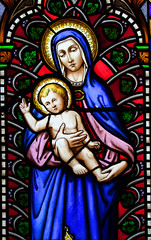 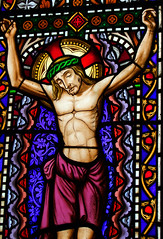 
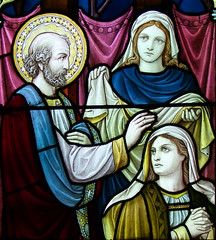   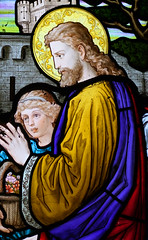
By contrast with the
chancel, the nave is startlingly plain, perhaps a result
of a considerable restoration in the early 20th Century.
The memorials are all gathered at the east end and
include one to Sir Eric Teichman. After a distinguished
career in the diplomatic service, mainly in China,
Teichman devoted his life to raising funds for Dr
Barnardos Homes. He lived at Honingham Hall, and in the
winter of 1944 he was shot dead in the grounds by two
American servicemen who were poaching there. The soldier
who fired the fatal shot with an M1 Carbine, a Private
George E Smith of Pittsburg, USA, was sentenced to death
and hung at Shepton Mallet prison on VE Day, despite a
call for clemency from Teichman's widow. Of course, the
memorial gives you none of these details, but the
incident was quite a cause celebré at the time,
I believe.
So it was all very
interesting, and despite the gloom of the nave I decided
that I liked Honingham church. We went out to the car and
set off for East Tuddenham.
But back
in 2006 we were still sitting in the porch, of course.
The snow gradually thinned, and at last it stopped. We
stepped out, examining the sky for signs. An uneasy truce
had set in. Just a thin dusting remained on the grass to
show that it had ever snowed; the sun was edging to come
out, the white rime on the green fading, but there were
more sheets of greying clouds huddled off in the
distance. It was time to go. We wanted to make a
statement of some kind, and so we left the porch gates
open, as if to suggest that the the doors were not
barred, and that God was in His dwelling house
waiting to bid a welcome.
But by the
time we got back to the car and headed eastwards past the
church, someone had already closed them.
Simon Knott, March 2006, revised and
updated May 2016
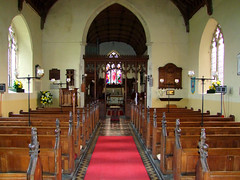 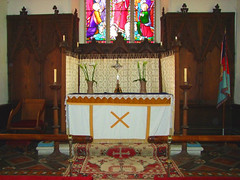 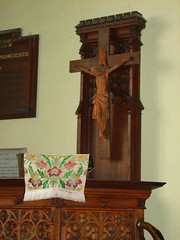  
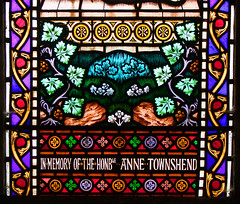 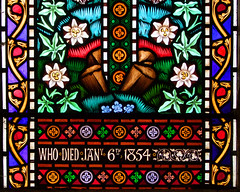 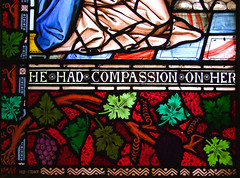 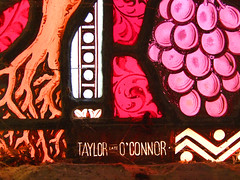
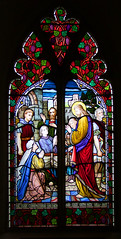 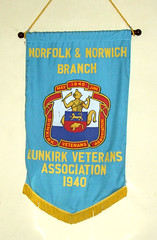

Amazon commission helps cover the running
costs of this site
|
|
|
